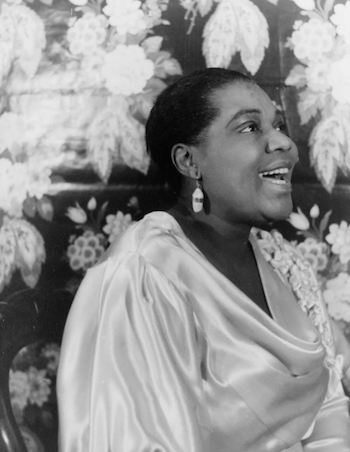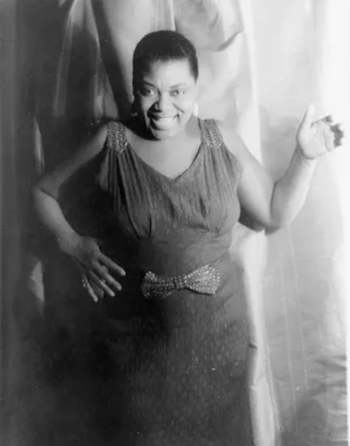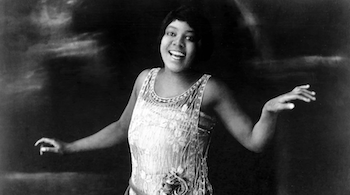
Elizabeth “Bessie” Smith was born on April 15th, 1894 in Chattanooga, Tennessee. Born as one of seven children, her father William Smith was a Baptist Minister and her mother Laura Smith was a laundress. Tragically, her father William Smith died soon after her birth in 1900 after a work accident, leaving her in the care of her mother.
In 1906, her mother died along with her sibling, Bud, leaving both of Smith’s parents dead before her eighth birthday. As a result, Smith grew up in poverty, raised by her older sister, Viola. To earn some money, Smith began performing as a street singer along with her brother, Andrew, who played guitar. However, Viola did not approve of her street performances, and punished Bessie and her brother for doing so.
Working as a performer, Bessie gained notoriety at a young age. At the young age of eight or nine, she made her first public appearance at the Ivory Theatre in Chattanooga. The first published mention of Smith’s performances was in The Freedman on May 8th, 1909, when she was around fourteen years old
Increasing her chances at fame, Smith’s sibling Clarence, invited her to be a member of the Moses Stokes traveling show in 1912. She was then hired as a dancer and soon after, Ma Rainey, one of the first blues artists, allowed Smith to tour with her in 1913. There, she was given some instruction from Ma Rainey, which developed her talents.

Following this, Smith was given a pair in the choir at a touring musical, then a part in several vaudeville shows, which she traveled for frequently. By 1918, she was given the starring part in these shows. She sang in bars and theaters for years in the South and on the East Coast, touring in bars and theaters and entertaining audiences with her powerful and unique voice. By 1921, she had a band accompanying her to her shows on the tour, adding a new level to her outstanding performances.
Smith married Earl Love in 1920, who died in 1922. After Love’s unexpected death in 1922, Smith moved to Philadelphia and got remarried to Jack Gee in 1923, who she met at a club he was a security guard for, and she was performing at. The couple eventually split in 1929, after a tumultuous marriage involving various affairs.
In 1923, Smith was discovered by Columbia Records and made her first recordings with them after going to New York City for an audition. She signed her contract with Columbia after being promised compensation of fifteen hundred dollars for twelve recorded songs. Her first recorded song “Downhearted Blues”, written by Lovie Austin and Alberta Hunter, sold 500,000 copies in its first year. Other songs recorded by her were: “Careless Love Blues,” “Empty Bed Blues,” “Gimme a Pigfoot”, and “Tain’t Nobody’s Biz-ness If I Do.” One of her most popular songs was “Nobody Knows You When You’re Down and Out,” written by Jimmy Cox, and recorded by Smith in 1929. These songs were raw and emotional, often discussing love, oppression, and poverty. Her vocal talents and new contract catapulted her into stardom, where she could collaborate with other famous musicians of her time. Her collaborations included “Backwater Blues” with James P. Johnson, “Cold in Hand Blues,” “I Ain’t Gonna Play No Second Fiddle,” and “St. Louis Blues” with Louis Armstrong.
Nicknamed the “Empress of the Blues”, Smith traveled far and wide to keep up with the demand, due to her popular recordings. She even became the highest-paid black artist in the country for a period of time, earning two thousand dollars per week. Her wealth was clear, as she was even able to acquire a custom Pullman sleeping car (a luxury railroad car) for the train that would accommodate her band when traveling to her shows.

Unfortunately, Smith’s career would go into decline during the Great Depression. Record companies started to cater to the demand for jazz instead of classic blues and Smith stopped working with Columbia Records in 1931. Due to this, Smith didn’t tour as much and tried to pander to new audiences. Smith continued to perform in venues, such as the Harlem Opera House, but her fame and popularity had decreased from its height.
On September 26, 1937, Smith was traveling near Memphis, Tennessee when she and her friend Richard Morgan got into a car accident. Smith passed away in Clarksdale, Mississippi due to injuries sustained by this accident. Her funeral was held in Philadelphia, where her death was mourned by many. She was buried in Mount Lawn Cemetery in Sharon Hill, Pennsylvania.
Smith’s legacy in music remained long after her passing, not only through her recordings but also the inspiration she ignited in many famous musicians, such as Janis Joplin. A biography titled Bessie by Chris Albertson, which detailed her life was printed in 1972 and expanded in 2003. Bessie, a film starring Queen Latifah released in 2015, was loosely based on her as well.
Smith was inducted into the Blues Hall of Fame in its inaugural class in 1980 and the Rock n’ Roll Hall of Fame in 1989. Her career not only served as inspiration within that of the Blues singer but women in general. Smith was inducted into the Women’s Hall of Fame in 1984, cementing her legacy as a legendary Blues artist. Not only left behind her songs, Smith lives on through the short film “St. Louis Blues”, filmed in 1929. Her songs and their notoriety now serve as a testament to how influential Smith was to her field. Her discography included that of 160 recorded songs, three of those being admitted to the Grammy Hall of Fame. These three include “Empty Bed Blues” in 1983, “St. Louis Blues” in 1993, and “Downhearted Blues” in 2006. Her legacy as “Empress of the Blues” is undoubtedly one of the greatest Blues singers of her time.
Why Did I Choose to Research Bessie Smith?
When trying to find a woman for my article, I found myself drawn to the idea of researching a musician. Of course, I wanted to research someone more unknown to people than the big stars of today, which is why Bessie Smith came to mind. While Blues music is not as prominent as it used to be in the 1920s, Smith’s impact on famous singers still stands the test of time. Her story can be shown as a story of persistence on the trek to stardom and her impact lies within the inspiration she has cast in numerous musicians.
Works Cited
Bessie Smith. (n.d.). National Museum of African American History and Culture. Retrieved August 27, 2024, from https://nmaahc.si.edu/lgbtq/bessie-smith
Bessie Smith. (2017, October 27). National Park Service. Retrieved August 27, 2024, from https://www.nps.gov/locations/lowermsdeltaregion/bessie-smith.htm
Biography.com Editors. (2014, April 2). Bessie Smith biography. Biography.com. Retrieved August 27, 2024, from https://www.biography.com/musicians/bessie-smith
Britannica, T. Editors of Encyclopaedia (2024, August 12). Bessie Smith. Encyclopedia Britannica. https://www.britannica.com/biography/Bessie-Smith
Mahon, M. (2019, August 5). How Bessie Smith influenced a century of popular music. Npr.org. Retrieved August 27, 2024, from https://www.npr.org/2019/08/05/747738120/how-bessie-smith-influenced-a-century-of-popular-music
New-York Historical Society. (n.d.). Life story: Bessie Smith (1894 or 1895–1937). Women & the American Story. Retrieved August 27, 2024, from https://wams.nyhistory.org/confidence-and-crises/jazz-age/bessie-smith/
This article was published on 11/13/24